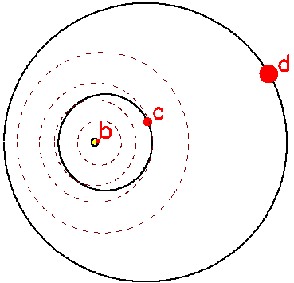Click on image for full size
Courtesy of the San Francisco State University Planet Search home page
Related links:
New Planets Discovered around the Star Upsilon Andromedae
News story originally written on May 5, 1999
The rush is on; the newest real estate in the universe has been discovered
orbiting the star Upsilon Andromedae, so get your claims in now!
Unfortunately, you might have a bit of trouble getting anything to grow or survive on these gas giant planets.
Recently two groups of astronomers working independently, from Lick Observatory near San Jose, California, and the Havard Smithsonian Center for Astrophysics in Cambridge, Massachusetts, found evidence that there are at least three planets orbiting the star. The discovery is the first multi-planet system around a normal star, other than our own, and came from close analysis of eleven years of telescope observations.
The closest and smallest planet was discovered three years ago, and is in an orbit closer than Mercury's would be. Both of the outer planets are on very elliptical orbits, common to other extrasolar planets discovered. The middle planet is estimated to be twice the size of Jupiter, and the outermost planet is at least four times Jupiter's mass. James P. Wright, head of special programs in astronomy at NSF's Division of Astronomical sciences said, "these planets are giants." He was also impressed that the results were independently drawn up by the teams.
These findings show that planetary systems might be common in the universe,
and raises the possibility that life might have developed in other places than on Earth.















